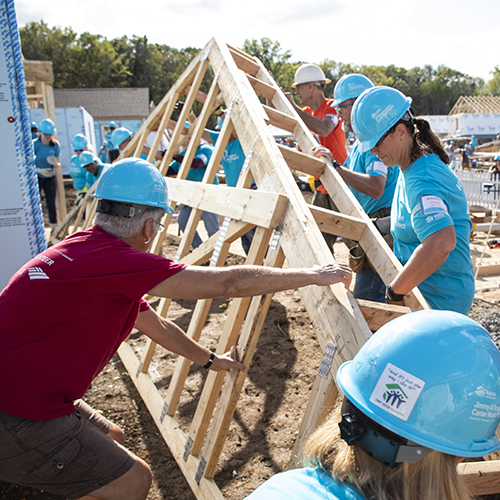Habitat for Humanity, a well-known nonprofit organization, has garnered a reputation for helping families acquire affordable housing through a combination of volunteer labor, donor funding, and homeowner sweat equity. Typically, it is celebrated for empowering homeownership and providing a unique model of community engagement. Despite its positive impact, there has been a breadth of criticism and controversy surrounding the organization, leading some to question the efficacy and fairness of its operations.

One major point of contention is the misconception that Habitat for Humanity provides free homes. The reality is that while homes are made more affordable through no-profit loans and volunteer work, recipients are required to pay for their homes, often contributing hundreds of hours of their own labor, known as ‘sweat equity’, to the construction of their own and others’ houses. This element can be problematic, especially for individuals who struggle to balance this commitment with other responsibilities.
Additionally, Habitat for Humanity faces challenges similar to those of any large organization, such as dealing with the high costs of construction and the complexities of funding and resourcing. These challenges have been amplified in times of economic hardship and were particularly pronounced during events like the COVID-19 pandemic, which saw a significant decrease in volunteer participation and an increase in material costs, notably impacting the organization’s operations.
Today, we will address the discussion why Habitat for Humanity is bad.
Foundational Concepts

In analyzing Habitat for Humanity, it’s essential to understand the organization’s structural aspects and how they may contribute to controversy or criticism.
Non-Profit Status and Mission
Habitat for Humanity is a nonprofit organization with a mission rooted in Christian principles, aiming to provide affordable housing to those in need. As a nonprofit, it operates under the expectation that its primary motive is service rather than profit. Some critics, however, scrutinize the organization for how it manages donations and its overall impact on the housing crisis.
Role of Volunteer Labor
Volunteers form the backbone of Habitat for Humanity’s operational model. They provide labor that keeps construction costs low, aiming to make homes more affordable. Nonetheless, the reliance on unpaid labor has attracted criticism for potential inconsistency in build quality and the organization’s capacity to deliver on its promise of aiding in the creation of stable and long-term housing solutions.
Principle of Sweat Equity
Habitat for Humanity incorporates a ‘sweat equity’ requirement, where the recipients of housing aid are expected to contribute a predetermined amount of their labor to the construction of their own or others’ homes. While this concept instills a sense of ownership and contribution, it has come under fire when the participants misinterpret or are unaware of the full implications of this commitment, which may include additional financial responsibilities or labor hours that are challenging for some to meet.
Program Structure

In exploring the criticisms of Habitat for Humanity, it is crucial to address the specifics of its program structure, from the selection of participants to the terms of homeownership.
Homeowner Selection Criteria
The selection process for potential homeowners is a focal point for critique. Habitat for Humanity targets low-income families as beneficiaries, but these families must meet several criteria to be considered eligible. The organization typically requires candidates to demonstrate:
- A need for better housing
- An ability to pay an affordable mortgage
- A willingness to partner through sweat equity
Mortgage Terms and Conditions
Concerns have been raised about the clarity and fairness of the mortgage terms and conditions. Even though mortgages provided by Habitat for Humanity do not profit the organization and do not include interest, they are not free. Applicants often learn the specifics of mortgage terms after completing requisite volunteer hours, raising questions about transparency.
Path to Homeownership
The path to homeownership with Habitat for Humanity includes mandatory sweat equity, where future homeowners contribute labor to the construction of their own or others’ homes. This engagement in the build process is intended to empower homeowners and foster a sense of community. However, this requirement can be strenuous and time-consuming for participants, some of whom might already be balancing multiple jobs and family responsibilities.
Impact Assessment
In assessing the effects of Habitat for Humanity, one must consider the repercussions on local communities and the organization’s approach to addressing issues like homelessness and the global housing crisis.
On Local Communities
Habitat for Humanity (HFH) is often envisioned as a beacon of hope for community development and providing affordable housing solutions. It partners with local residents to build or improve homes, aiming to create lasting and positive change within neighborhoods. However, critics argue that while HFH brings volunteers and resources to an area, it may not always result in sustainable development. Communities may become reliant on external aid, and the lasting impact of the organization’s efforts on local economies is sometimes questioned.
- Community Impact Variables:
- Volunteer involvement: Can foster a spirit of community but might not always translate to long-term engagement
- Homeowner education: Is provided, yet effectiveness over time varies
- Local resource use: May lead to a transient boost rather than long-term economic support
Addressing Homelessness
Habitat for Humanity contributes to mitigating the global housing crisis by offering a “hand up” rather than a “handout.” Through its model of affordable home ownership, which requires ‘sweat equity’ and homeowner mortgage payments, HFH attempts to provide a long-term solution to homelessness. The organization’s approach, however, has been scrutinized for potentially placing an onerous burden on individuals who are already financially strained. Critics claim that the requirement for ‘sweat equity’—the labor homeowners must provide—can be problematic for those with preexisting job commitments and family responsibilities.
- Homelessness Alleviation Factors:
- ‘Sweat equity’: A requirement for HFH homeowners that may present challenges
- Mortgage arrangements: Offer a pathway to ownership but can add financial pressure
- Housing stability: Is a goal, though the success rate varies by region and individual circumstances
Financial Practices
Habitat for Humanity’s financial practices have come under scrutiny due to their management of donations and revenue, along with their mortgage payment process. Concerns center around the transparency and allocation of funds in addition to the terms of the homeownership agreements.
Management of Donations and Revenue
Donations to Habitat for Humanity are intended for the construction and rehabilitation of homes for those in need. Revenue management, particularly how these funds are allocated to local chapters versus administrative costs, is essential for maintaining donor trust. Critics argue that a lack of clarity on how donations are distributed can lead to questions about the efficiency and impact of the donor’s contributions.
Mortgage Payment Process
Habitat for Humanity provides houses not as giveaways but through a mortgage payment system, where homeowners are expected to pay back the cost of the house through affordable payments. The organization outlines these terms clearly; nevertheless, some homeowners may find the “no-profit” loan terms or the arrangement for a lump sum payment at the end of the term confusing. It is crucial that all payment expectations and schedules are understood to prevent feelings of discontent or misunderstanding about the financial obligations involved.
- Mortgage Payments: Structured on an affordable basis, often with zero-interest loans
- Revenue: Generated from mortgage payments is utilized to fund the construction of more homes
- Donations: Serve as a primary financial resource and are significant for the organization’s housing projects
Operational Challenges

Habitat for Humanity faces notable hurdles in optimizing operations, notably in the areas of resource allocation and affiliate coordination, which are crucial for the non-profit’s mission.
Resource Allocation
Ineffective distribution of resources directly impacts Habitat for Humanity’s ability to effectively execute its mission. Affiliates may struggle when they receive inconsistent funding and material support, which can lead to project delays. The allocation of finances, building materials, and land often varies, influenced by economic fluctuations and market conditions. Under these circumstances, contractors and volunteers may find it difficult to sustain momentum and meet the housing needs.
- Financial Resources: Variability in donations can lead to an inconsistent budgetary framework
- Building Materials: Costs and availability can hinder or delay construction efforts
- Land: Scarcity and regulatory barriers can complicate acquisition processes
Affiliate Coordination
Affiliates play a pivotal role in Habitat for Humanity’s operational framework, but they encounter challenges in maintaining uniform standards and practices due to the decentralized nature of the organization. Collaboration between affiliates and the overarching Habitat for Humanity organization is critical for sharing best practices, fostering volunteer engagement, and ensuring that partnerships with local entities are productive and mutually beneficial.
- Standards and Practices: Differing local regulations and capabilities can lead to discrepancies.
- Volunteer Engagement: Each affiliate’s ability to mobilize and manage volunteers can vary widely.
- Local Partnerships: The success of local collaborations can be uneven, affecting project outcomes.
Controversies and Criticism
Habitat for Humanity, a widely recognized nonprofit organization known for providing affordable housing, has faced various criticisms and controversies including ethical and legal concerns, issues with gentrification, and organizational disputes seen in the split with the Fuller Center for Housing.
Ethical and Legal Controversies
Within the ethical and legal realms, Habitat for Humanity has encountered criticism for not providing free homes, contrary to a common misconception. Instead, recipients must pay for their homes through a combination of labor, commonly referred to as “sweat equity”, and affordable mortgages. The organization’s approach to sweat equity has been scrutinized when homeowners were unaware of the full extent of their financial obligations, which raises concerns of transparency and informed consent.
Issues with Gentrification
Another criticism revolves around Habitat for Humanity’s role in gentrification. Some argue that the organization’s projects, particularly when they involve purchasing and renovating multi-family buildings in economically disadvantaged, yet gentrifying areas, can inadvertently contribute to increased property values. This rise may catalyze a cycle of displacement for current residents who can’t afford the uptick in prices, therefore undercutting its efforts to stabilize communities through homeownership.
Fuller Center for Housing Split
The Fuller Center for Housing was established following a split with Habitat for Humanity, illustrating a notable controversy within the affordable housing advocacy sector. Fundamentally, the split arose from differences in vision and operational philosophies between the founders. Some specific points of divergence included the handling of finances and the approach to assisting homeowners facing foreclosure rates, which is a critical measure of any housing program’s long-term success.
Public Perception and Stigma
This section addresses the challenges Habitat for Humanity faces due to misconceptions and the associated stigma. These issues have a ripple effect on community dynamics and local property values.
Community Stigma
In some neighborhoods, Habitat for Humanity homes can carry a stigma, leading to misconceptions about the nature of the assistance they provide. Contrary to the belief that these homes are freely given, recipients are actually required to invest “sweat equity” and to pay an affordable mortgage. This requirement is designed to foster a sense of ownership and commitment but may be overlooked, resulting in a stigma that Habitat for Humanity homes are handouts, affecting community sentiments.
Impact on Property Values
Another area of concern regards the impact of Habitat for Humanity properties on local property values. There is a common belief that the introduction of these homes into a community can lead to a reduction in property values. However, evidence on this point is not conclusive. While some studies suggest there might be a short-term effect on surrounding property values, the long-term effect often shows improvement or stabilization due to homeowners investing in the maintenance of their properties and the overall community.
Role of Public Figures
Public figures have played significant roles in the perception and activities of Habitat for Humanity. Their involvement often shapes public opinion and influences the organization’s reach.
Involvement of Jimmy Carter
Jimmy Carter, the 39th President of the United States, has been indelibly associated with Habitat for Humanity. His high-profile participation has brought substantial attention and credibility to the organization. As a hands-on volunteer, his carpentry work and advocacy have turned the spotlight onto Habitat for Humanity’s mission, drawing volunteers and donations.
Legacy of Linda Fuller
Linda Fuller, along with her husband Millard, was key in founding Habitat for Humanity. Her ongoing commitment reflects a devotion to service and a keen leadership in fostering community housing efforts. Her legacy includes mobilizing volunteers and promoting simple, decent housing as a right for all. Linda Fuller’s role embodies the heart and determination behind the nonprofit’s vision.
Future Directions and Sustainability

Within the realm of Habitat for Humanity’s operations, sustainability measures and the education of stakeholders are pivotal for its future direction. These elements are essential to both resource conservation and community empowerment.
Sustainable Practices
Habitat for Humanity recognizes the importance of sustainable building practices and eco-conscious material choices that strive to minimize environmental impact. They employ energy-efficient construction methods, such as:
- Utilizing green building techniques
- Selecting sustainable materials
- Reducing the carbon footprint of construction projects
Moreover, to support sustainability, Habitat for Humanity encourages volunteer involvement to help decrease labor costs without compromising construction quality.
Education and Empowerment Pathways
Education serves as a cornerstone for Habitat for Humanity, particularly in enabling homeowners to understand complex aspects such as finance and property maintenance. They facilitate:
- Financial education workshops for future homeowners
- Engaging with the community to elevate understanding of sustainability
This strategy empowers individuals and ensures a faith-based and community-driven approach to homeownership and property upkeep. Habitat for Humanity’s focus on educating stakeholders supports long-term empowerment and sustainable community development.


0 Comments